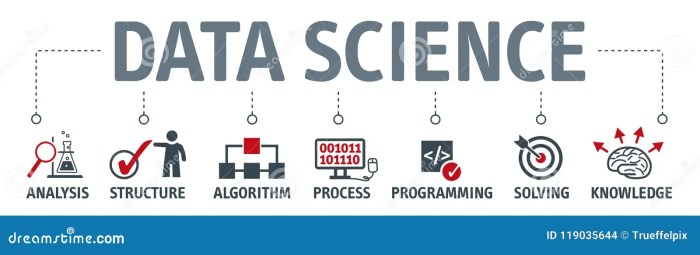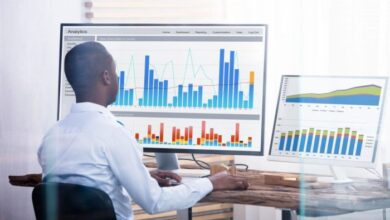
Definition of data science: This exploration delves into the core principles, processes, tools, and applications of this rapidly evolving field. Data science is more than just analyzing numbers; it’s about extracting meaningful insights from data to drive informed decisions and solve complex problems across various industries. From understanding the historical context to exploring the ethical considerations, we’ll uncover the multifaceted nature of data science.
The field encompasses a wide range of skills and techniques, from statistical modeling and machine learning to data visualization and cloud computing. This journey will guide you through the stages of a typical data science project, highlighting the importance of data collection, preparation, analysis, and interpretation. Furthermore, we’ll examine the critical roles within a data science team, the tools and technologies used, and the ethical implications of data handling.
Defining Data Science
Data science is an interdisciplinary field that uses scientific methods, processes, algorithms, and systems to extract knowledge and insights from structured and unstructured data. It blends elements of statistics, computer science, domain expertise, and visualization to uncover patterns, trends, and relationships within data, ultimately enabling informed decision-making. This knowledge extraction is increasingly crucial in today’s data-rich environment.Data science is more than just crunching numbers; it involves a holistic approach to understanding data.
It necessitates not only technical skills but also a deep understanding of the business problem being addressed. It requires a combination of analytical thinking, creativity, and effective communication to translate complex data insights into actionable strategies.
Defining Data Science: A Comprehensive View
Data science is a multi-faceted field, drawing from various disciplines. It transcends simple data analysis by encompassing the entire data lifecycle, from data collection and cleaning to model building, deployment, and evaluation. Crucially, it integrates domain expertise to contextualize the findings and ensure relevance to the specific problem being investigated.
“Data science is an interdisciplinary field that uses scientific methods, processes, algorithms, and systems to extract knowledge and insights from structured and unstructured data.”
Key Characteristics Distinguishing Data Science
Data science differs from other fields like statistics, machine learning, or business intelligence by its holistic approach. Data science emphasizes the entire data lifecycle, including data collection, preparation, analysis, interpretation, and deployment. It also incorporates domain knowledge and communication skills, making it distinct from purely technical disciplines.
- Focus on the entire data lifecycle: Data science considers the entire data pipeline, from initial data collection to final deployment of insights. This contrasts with more specialized fields that might focus on a particular stage of the process.
- Integration of domain expertise: Data scientists leverage knowledge from the specific industry or business area to interpret data and apply insights effectively. This is essential for translating technical findings into actionable strategies.
- Emphasis on communication and visualization: Data scientists need to communicate complex insights to non-technical audiences. Effective visualization tools and clear explanations are crucial for conveying the meaning and impact of the findings.
Historical Context and Evolution of Data Science
The field of data science has evolved significantly over time, mirroring the growth in computing power and data availability. Early roots can be traced back to statistical analysis, but the convergence of big data, advanced algorithms, and computing power marked a significant turning point.
- Early Roots in Statistics: Early statistical methods formed the foundation for analyzing data. Techniques like regression analysis and hypothesis testing were crucial for understanding data patterns.
- Rise of Machine Learning: The development of machine learning algorithms provided the tools to automate data analysis and prediction tasks. This marked a significant shift towards automated insights.
- The Big Data Era: The explosion of data volume, velocity, and variety (known as the “3 Vs”) propelled data science into prominence. This era highlighted the need for scalable solutions and efficient data processing.
Core Principles Underpinning Data Science Methodologies
Data science methodologies are built upon a set of core principles that guide the process of extracting meaningful insights. These principles encompass ethical considerations, robust analysis, and effective communication.
- Objectivity and rigor: Data scientists must approach data analysis with a focus on objectivity and rigorous methodology. This involves using established statistical techniques and avoiding biases.
- Reproducibility and transparency: Data analysis should be reproducible, allowing others to verify the findings and understand the methodology. Transparency is key to building trust and confidence in the results.
- Ethical considerations: Data science has ethical implications, particularly when dealing with sensitive data. Data scientists must adhere to ethical guidelines and regulations when handling and analyzing data.
Common Roles within a Data Science Team
Data science teams are composed of individuals with diverse skill sets. The roles and responsibilities vary, but all contribute to the overall goal of extracting valuable insights from data.
| Role | Responsibilities | Required Skills |
|---|---|---|
| Data Scientist | Conducting data analysis, building predictive models, and developing data-driven solutions. | Programming (Python, R), statistical modeling, machine learning, data visualization, communication |
| Data Engineer | Designing, building, and maintaining data pipelines, ensuring data quality and accessibility. | Database management, data warehousing, ETL (Extract, Transform, Load) processes, cloud computing |
| Machine Learning Engineer | Deploying and maintaining machine learning models in production environments. | Machine learning algorithms, cloud computing, DevOps, model evaluation |
| Business Analyst | Understanding business problems, translating them into data questions, and communicating data insights to stakeholders. | Business acumen, data interpretation, communication, data visualization |
Data Science Process
Data science is not a one-time event; it’s a cyclical process. From initial problem definition to deployment of solutions, understanding the project lifecycle is crucial for successful data-driven decision-making. This process involves iterative steps, allowing for adjustments and refinements throughout the project.
Data Collection and Preparation
Data collection is the cornerstone of any data science project. Gathering relevant and high-quality data is paramount to achieving meaningful insights. Data quality is not just about the quantity of data but also about its accuracy, completeness, and consistency. The data must be appropriate for the analysis techniques to be used. Raw data often needs cleaning, transformation, and restructuring before it can be analyzed.
This crucial preprocessing step can involve handling missing values, removing outliers, and converting data into a suitable format.
Data Analysis Techniques
Various data analysis techniques are employed in data science, each suited to different types of problems and data. These techniques range from descriptive statistics to complex machine learning algorithms. Descriptive statistics, like mean, median, and standard deviation, summarize and describe the data. Exploratory data analysis (EDA) techniques uncover patterns and relationships within the data. More advanced techniques include regression analysis for modeling relationships between variables, clustering for grouping similar data points, and classification for categorizing data points.
Supervised vs. Unsupervised Learning
Supervised and unsupervised learning are two fundamental categories of machine learning algorithms. Supervised learning algorithms learn from labeled data, where each data point is associated with a specific target variable. Examples include classification (predicting categories) and regression (predicting continuous values). Unsupervised learning algorithms, on the other hand, work with unlabeled data. They aim to discover hidden patterns, structures, and relationships within the data.
Clustering is a common unsupervised learning technique. An example of supervised learning is predicting customer churn, while an example of unsupervised learning is segmenting customers based on purchasing behavior.
Data Visualization Techniques
Data visualization is a powerful tool for understanding and communicating insights gained from data analysis. Choosing the right visualization technique is critical for effective communication.
Data science, in simple terms, is about extracting insights from data. It’s a multi-faceted field, drawing on various disciplines like statistics and computer science. Understanding how Harvard manages its funding, for example, through grants and endowments, is important for grasping the complexities of how large-scale projects are supported, like data science initiatives. Knowing how Harvard’s funding works, how Harvard funds its operations provides valuable context for understanding the potential of data science projects on a larger scale.
Ultimately, data science’s power lies in its ability to analyze vast datasets to uncover patterns and drive decision-making.
| Visualization Technique | Use Case | Suitable Tools |
|---|---|---|
| Bar Charts | Comparing categories, showing frequency distributions | Tableau, Power BI, Matplotlib |
| Histograms | Representing the distribution of a single variable | Tableau, Power BI, Seaborn |
| Scatter Plots | Identifying relationships between two variables | Tableau, Power BI, Matplotlib, Seaborn |
| Line Charts | Showing trends over time | Tableau, Power BI, Matplotlib |
| Box Plots | Summarizing distributions and identifying outliers | Tableau, Power BI, Seaborn |
| Heatmaps | Representing relationships between multiple variables | Tableau, Power BI, Seaborn |
Visualizations facilitate the interpretation of complex data sets and help stakeholders make informed decisions. Different visualization tools are suitable for different levels of complexity and visual needs.
Data Science Tools and Technologies
Data science is a multifaceted field, requiring a robust toolkit of tools and technologies. From programming languages and libraries to visualization tools and cloud platforms, mastering these components is crucial for successful data analysis and modeling. Choosing the right tools depends on the specific task and the nature of the data being analyzed. This section will delve into the essential tools and technologies used in data science projects.
Common Programming Languages
Data scientists frequently utilize various programming languages. Python, with its extensive libraries, remains a dominant choice. Its readability and versatility make it suitable for diverse data science tasks, including data manipulation, statistical modeling, and machine learning. R, another popular language, excels in statistical computing and data visualization, offering specialized packages for advanced analyses. Both languages have vast communities and readily available resources, ensuring support and continuous improvement.
Data Science Libraries and Frameworks
Numerous libraries and frameworks streamline data science workflows. Pandas in Python provides powerful data manipulation capabilities, enabling efficient data cleaning, transformation, and analysis. NumPy facilitates numerical computations, essential for handling large datasets and complex algorithms. Scikit-learn is a comprehensive machine learning library offering various algorithms for classification, regression, and clustering. TensorFlow and PyTorch are popular deep learning frameworks, enabling the development of sophisticated neural networks for complex tasks.
These tools provide a foundation for building data-driven applications.
Data Visualization Tools
Effective visualization is key to understanding and communicating insights from data. Matplotlib and Seaborn, Python libraries, offer a range of plotting options for creating static, interactive, and dynamic visualizations. Tableau and Power BI are popular business intelligence tools that enable interactive data exploration and visualization, making complex data easily understandable. These tools help transform raw data into meaningful insights.
Cloud Platforms in Data Science
Cloud platforms are integral to modern data science. They offer scalable computing resources, robust storage solutions, and powerful tools for data analysis and machine learning. Amazon Web Services (AWS), Microsoft Azure, and Google Cloud Platform (GCP) are leading providers, offering various services for data storage, processing, and modeling. These platforms allow data scientists to access and manage vast datasets, enabling them to perform sophisticated analyses without the limitations of on-premises infrastructure.
Data Storage and Management
Efficient data storage and management are critical in data science projects. Well-structured data repositories ensure data quality and accessibility. Data storage systems should be scalable, secure, and optimized for efficient retrieval. Data management involves implementing strategies for data versioning, backups, and access control to maintain data integrity and prevent data loss.
Data science, in simple terms, is about finding patterns and insights in large datasets. This kind of analysis could be incredibly valuable in understanding complex societal issues, like the rising pregnancy-related death rates in the US. Pregnancy related death rates rise us highlight the urgent need for data-driven solutions. Ultimately, data science aims to provide actionable knowledge, leading to positive change.
Cloud-Based Data Storage Solutions
Different cloud platforms offer various data storage solutions. These platforms typically provide managed services for storage, reducing the overhead of maintaining infrastructure.
| Cloud Platform | Storage Solution | Features |
|---|---|---|
| Amazon S3 | Simple Storage Service | Scalable, cost-effective, high availability, object storage |
| Azure Blob Storage | Blob Storage | Highly scalable, flexible, geo-redundant storage options |
| Google Cloud Storage | Cloud Storage | High performance, global distribution, secure, cost-effective |
Data Science Applications
Data science is no longer a niche field; its applications are rapidly expanding across various industries, transforming how businesses operate and make decisions. From predicting customer behavior to optimizing supply chains, data science offers powerful tools for gaining insights and driving innovation. This section delves into the diverse applications of data science, highlighting real-world examples and the impact on business strategies.
Applications Across Industries
Data science’s impact transcends traditional boundaries. Its ability to analyze vast datasets allows businesses to identify patterns, trends, and insights previously hidden within the data. This leads to improved decision-making, enhanced efficiency, and a competitive edge. Different industries leverage data science in unique ways, tailored to their specific needs and challenges.
Retail Industry Applications
Retailers utilize data science to understand customer preferences and optimize their strategies. Analyzing purchase history, browsing behavior, and demographics allows businesses to personalize recommendations, target marketing campaigns, and improve inventory management. For example, Amazon uses data science to recommend products to customers, leading to increased sales and customer satisfaction.
Healthcare Applications
Data science is revolutionizing healthcare by improving diagnostics, treatment plans, and patient outcomes. Analyzing medical images, patient records, and research data helps identify patterns indicative of diseases, predict patient risk, and develop personalized treatment plans. One example is the use of machine learning algorithms to detect cancerous cells in medical images with greater accuracy than traditional methods.
Finance Industry Applications
In the financial sector, data science is employed to detect fraud, assess risk, and optimize investment strategies. By analyzing transaction data, market trends, and customer behavior, financial institutions can improve fraud detection systems, make more informed investment decisions, and provide personalized financial services. A real-world example includes using machine learning to predict stock market trends, although these predictions are not guaranteed and should be approached with caution.
Manufacturing Industry Applications
Manufacturing companies leverage data science to optimize production processes, predict equipment failures, and improve quality control. By analyzing sensor data from machines, production lines, and other sources, manufacturers can identify patterns indicative of potential problems, predict equipment failures, and optimize resource allocation. Predictive maintenance, based on historical data and machine learning models, minimizes downtime and improves efficiency.
Table: Data Science Applications in Various Industries
| Industry Vertical | Typical Use Cases |
|---|---|
| Retail | Personalized recommendations, targeted marketing, inventory optimization, customer segmentation |
| Healthcare | Disease prediction, personalized treatment plans, drug discovery, medical image analysis |
| Finance | Fraud detection, risk assessment, algorithmic trading, customer churn prediction |
| Manufacturing | Predictive maintenance, quality control, process optimization, supply chain management |
| Transportation | Route optimization, traffic prediction, logistics management, fuel efficiency |
Data Science Skills and Competencies: Definition Of Data Science

Data science is a rapidly evolving field requiring a diverse skill set. Beyond the technical aspects of programming and data manipulation, successful data scientists possess a blend of analytical, communication, and interpersonal abilities. This section will delve into the crucial skills needed to excel in this dynamic domain.
Essential Skills for Data Scientists
Data scientists must possess a strong foundation in several key areas. Technical proficiency in programming languages like Python and R is paramount for data manipulation, analysis, and modeling. A solid understanding of statistical concepts is essential for drawing meaningful conclusions from data. Beyond the technical, strong communication and presentation skills are critical for conveying complex findings to both technical and non-technical audiences.
Importance of Statistical Knowledge and Mathematical Reasoning
Statistical knowledge is fundamental to data science. It enables data scientists to understand data distributions, identify patterns, and make inferences about populations. Mathematical reasoning allows for the development and application of sophisticated algorithms and models. For example, understanding concepts like hypothesis testing, regression analysis, and probability distributions is crucial for accurate data interpretation and model building. A strong mathematical foundation empowers data scientists to critically evaluate results and develop robust solutions.
Importance of Strong Communication and Presentation Skills
Effective communication is vital for data scientists to translate complex technical insights into actionable knowledge. This involves clearly articulating findings, explaining methodologies, and presenting recommendations in a concise and understandable manner. Data scientists need to be able to explain intricate statistical analyses to diverse audiences, from fellow data professionals to business leaders. This requires the ability to adapt communication styles to different levels of technical expertise.
Data science, simply put, is about extracting knowledge and insights from data. Understanding complex relationships in datasets is key. For example, analyzing diplomatic trends in South Korea’s relations with Syria under its new government, and how this might affect North Korea’s alliances, south korea diplomatic relations syria new government north korea allies , requires powerful analytical tools.
Ultimately, data science helps us understand the world around us, whether it’s geopolitical shifts or consumer trends.
Presentations should be compelling and visually engaging, employing charts, graphs, and other visual aids to enhance understanding.
List of Soft Skills Crucial for Data Scientists
Strong soft skills are as important as technical skills in the data science profession. These skills foster collaboration, problem-solving, and effective teamwork.
- Collaboration and Teamwork: Data science projects often involve teams with diverse skill sets. The ability to collaborate effectively, share knowledge, and work productively with others is essential for success.
- Problem-Solving: Data scientists are often tasked with identifying and solving complex problems. A strong problem-solving approach involves analyzing the situation, gathering relevant data, and proposing and evaluating potential solutions.
- Critical Thinking: Evaluating data and information critically is vital for making sound judgments and drawing reliable conclusions. Data scientists must be able to identify biases, evaluate the validity of assumptions, and avoid making unwarranted generalizations.
- Adaptability and Learning Agility: The field of data science is constantly evolving. Data scientists must be able to adapt to new technologies, tools, and methodologies. A willingness to learn and embrace new knowledge is critical for staying relevant and effective.
- Time Management and Organization: Data science projects often involve handling large amounts of data and numerous tasks. Effective time management and organizational skills are crucial for completing projects on time and efficiently.
Importance of Critical Thinking and Problem-Solving Skills
Data scientists need to approach problems with a critical and analytical mindset. They must not only identify the problem but also understand the context, possible causes, and potential solutions. Effective problem-solving involves breaking down complex issues into smaller, manageable components. This systematic approach leads to a more thorough understanding of the situation and the development of more effective solutions.
For example, a data scientist might need to determine the cause of a drop in sales. Critical thinking would involve examining various factors, such as market trends, competitor activity, and product performance, to pinpoint the root cause.
Data Science Certifications and Their Benefits
Data science certifications offer a structured path for professionals to gain recognition and enhance their skillsets. The choice of certification depends on individual career goals and existing expertise.
| Certification | Provider | Benefits |
|---|---|---|
| Google Data Analytics Professional Certificate | Provides a comprehensive introduction to data analysis, including data collection, cleaning, and visualization techniques. | |
| IBM Data Science Professional Certificate | IBM | Covers a range of data science topics, including machine learning, data mining, and predictive modeling. |
| Coursera Data Science Specialization | Coursera | Provides a rigorous curriculum with hands-on projects and assessments, helping students build practical data science skills. |
| DataCamp Data Science Career Track | DataCamp | Focuses on practical skills in data analysis and programming, offering a structured path to career advancement. |
Data Science Ethics and Considerations
Data science, while offering powerful tools for understanding and acting on data, comes with significant ethical responsibilities. The ability to analyze vast datasets and make predictions can have profound impacts on individuals and society, demanding careful consideration of potential biases, privacy concerns, and responsible usage. Ignoring these considerations can lead to harmful outcomes, reinforcing existing inequalities or infringing on fundamental rights.Data science practices must be guided by ethical principles and a commitment to fairness, transparency, and accountability.
This includes proactive measures to mitigate potential harm and ensure that the benefits of data science are shared broadly and equitably.
Ethical Implications of Data Science Practices, Definition of data science
Data science techniques can perpetuate and amplify existing societal biases if not carefully implemented. Algorithms trained on biased data can produce biased outputs, leading to discriminatory outcomes in areas like loan applications, hiring processes, and even criminal justice. For example, if a loan application model is trained on historical data that reflects existing societal biases, it may unfairly deny loans to certain demographic groups.
This highlights the critical need for careful data collection, preprocessing, and model validation to identify and mitigate potential biases.
Importance of Data Privacy and Security
Protecting sensitive data is paramount in data science. Data breaches can have devastating consequences, impacting individuals’ privacy and potentially leading to financial and reputational damage. Data scientists must adhere to strict data privacy regulations, such as GDPR (General Data Protection Regulation), and employ robust security measures to safeguard data throughout its lifecycle. Ensuring data anonymization and de-identification techniques are implemented to protect sensitive information is critical.
For example, companies must encrypt personal data during transmission and storage to prevent unauthorized access.
Potential Biases in Data and Their Impact
Data sets often contain inherent biases reflecting societal inequalities. These biases can be conscious or unconscious, but they can significantly impact the accuracy and fairness of data science models. Bias in data can lead to inaccurate predictions or recommendations, resulting in discriminatory outcomes. For example, if a facial recognition system is trained primarily on images of light-skinned individuals, it may perform poorly or inaccurately identify individuals with darker skin tones.
The impact can range from misidentification in law enforcement to discriminatory outcomes in hiring or lending decisions.
Importance of Responsible Data Usage
Responsible data usage extends beyond technical considerations. Data scientists have a responsibility to consider the societal implications of their work and ensure that their models and applications are used ethically. This involves careful consideration of potential harms and benefits, transparency in data collection and model deployment, and ongoing monitoring of the impacts of data science solutions. The need to consider long-term impacts of data usage is vital.
For instance, using data to personalize education can be beneficial, but data bias in the model can result in unequal educational outcomes.
Examples of Ethical Dilemmas in Data Science
Several ethical dilemmas arise in data science, demanding careful consideration and ethical frameworks. Examples include the use of data to predict criminal behavior, the potential for manipulation through targeted advertising, and the privacy implications of using data for personalized medicine. One example is the ethical considerations of using data from social media to predict political outcomes.
Ethical Guidelines and Principles for Data Science Projects
| Ethical Guideline | Description |
|---|---|
| Data Collection | Data should be collected ethically and legally, with informed consent and transparency. Avoid collecting data that is unnecessary or that infringes on privacy. |
| Data Processing | Data should be processed fairly and accurately, avoiding biases and ensuring data quality. Use appropriate methods for data anonymization and de-identification. |
| Model Development | Models should be developed with transparency and fairness in mind, addressing potential biases and validating their accuracy and reliability. |
| Model Deployment | Deploy models responsibly, considering potential societal impacts and mitigating potential harms. Provide clear explanations for model outputs and ensure accountability. |
| Data Sharing | Share data and model outputs responsibly, respecting privacy and security. Seek to make models understandable and accessible. |
Closing Notes
In conclusion, data science is a powerful tool for understanding and leveraging data to create value. Its applications span numerous industries, impacting everything from healthcare and finance to marketing and retail. We’ve explored the key aspects of this dynamic field, from its foundational principles to the ethical considerations. By understanding the definition of data science and its multifaceted nature, we can appreciate its growing significance in today’s data-driven world.





